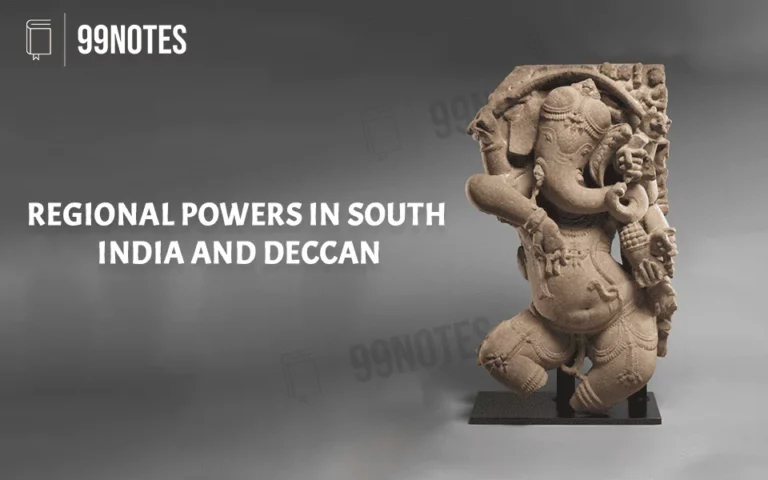Mughal Empire- Complete UPSC Notes
Mughal Empire
Babur, a Central Asian ruler descendant of the Turco-Mongol conqueror Timor, founded the Mughal Empire. He laid the foundation of the mighty Mughal Empire, which was consolidated by Akbar, and lasted for about two centuries.
The Mughal Empire reached its zenith during Aurangzeb’s rule, after which its decline started, catalysed by its conflict with the Marathas.
Mughal Rulers List with Timeline:
- Babar
- Humayun
- Akbar (1556-1605)
- Jahangir (1605-1627)
- Shah Jahan (1627-1658)
- Aurangazeb (1657-1707)
- Bahadur Shah I (1707-1712)
- Jahandar Shah (1712)
- Farrukhsiyar (1713-1719)
- Rafi Ul-Darjat (1719)
- Shah Jahan II (1719)
- Muhammad Shah (1719-1748)
- Ahmad Shah Bahadur (1748-1754)
- Alamgir II (1754-1759)
- Shah Jahan III (1759)
- Shah Alam II (1760-1788)
- Akbar Shah II (1806-1837)
- Bahadur Shah II (1837-1857) – The last Mughal emperor
Babur(1526-1530 CE)
- Babur(Zahiruddin Muhammad) was a descendant of the Turco-Mongol conquerorTimur on his father and from Genghis Khan on his mother’s side.
- The Timurids had control over all of central Asia in the 15th But they were forced out by the expanding Safavid power.
- Babur ascended the throne of a small Fergana state at 12 but immediately lost control over his ancestral place.
- In 1504, Babur Seized Kabul at the age of 24 and then entered India through Khyber Pass.
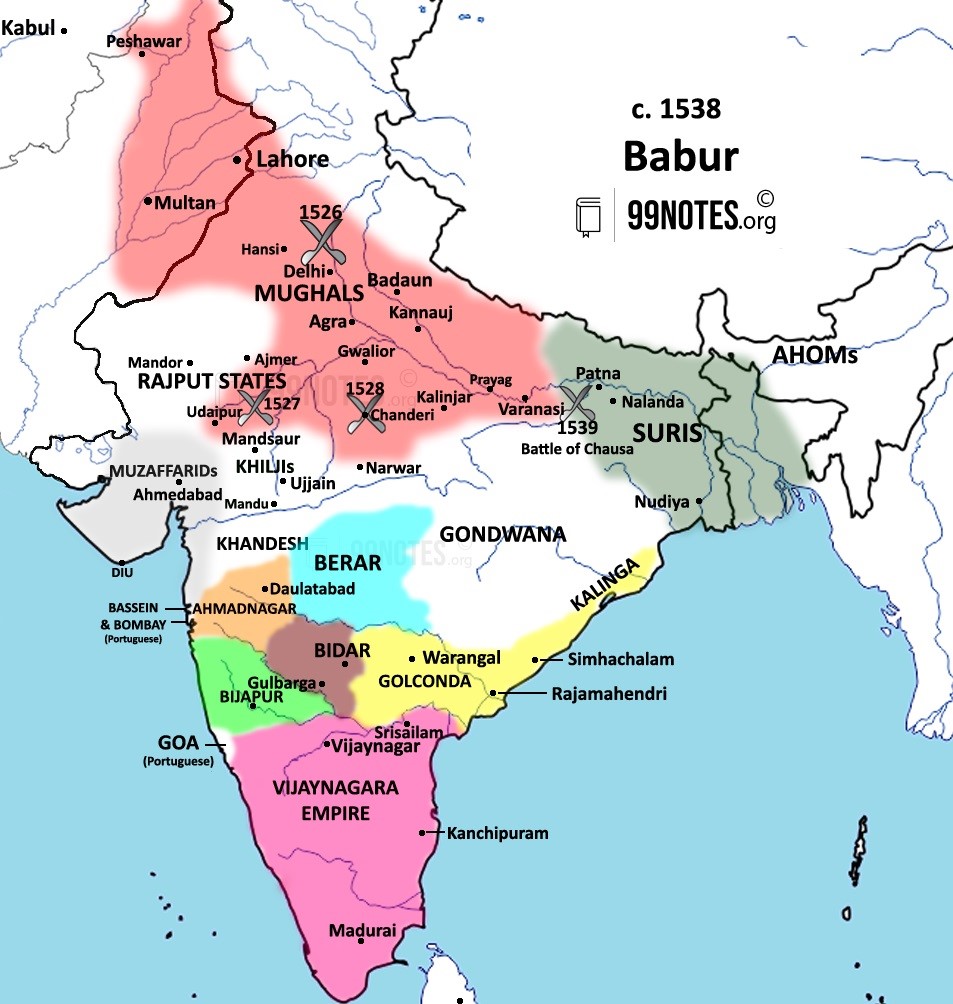
Babar war List:
| Sr. No. | BABAR War List | Year |
| 1 | First Battle of Panipat | 1526 |
| 2 | Battle of Khanwa | 1527 |
| 3 | Battle of Chanderi | 1528 |
| 4 | Battle of Ghagra | 1529 |
1. First Battle of Panipat, 1526:
-
- Ibrahim Lodi of the Lodi dynasty had the ambition to create a powerful and centralised empire which alarmed the Afghan chiefs and Rajputs. Babur came to India at the invitation of Daulat Khan Lodi(the Governor of Punjab) and perhaps Rana Sanga.
- With support from Safavid rulers in Persia and Ottomans, Babur defeated Ibrahim Lodi in the first battle of Panipat in 1526 and captured the throne of Delhi.
2. Battle of Khanwa, 1527
Babur accused Rana Sanga of breaching trust that Rana Sanga did not join him in his fight against Ibrahim Lodi.
- Babar declared jihad against Rana Sanga to rally his soldiers and finally won the fiercely contested battle.
3. Battle of Chanderi, 1528
Babur defeated Medini Rai of Chanderi in Malwa in 1528.
4. Battle of Ghagra, 1529
Faced with combined forces of Afghans who held sway in eastern India and Nusrat Shah of Bengal, Babur compelled them to retreat but could not win a decisive victory.
Shortly afterwards, he died near Lahore while on his way to Kabul in 1530 CE.
Evaluation of Babur’s regime:
-
- For the first time since the Kushan Empire, Kabul and Qandahar became integral parts of an empire in north India.
- Popularised use of gunpowder and artillery in warfare in India.
- Babur knew many languages, including Persian and Arabic. He wrote his autobiography Tuzuk-i-Baburi in Turkish, which sheds light on his military strategy.
Reasons for the Mughal Success
-
- Better firepower: Baburnama shows how he encircled the Lodhi forces to bring them into the direct line of fire of his artillery.
- Supply of horses: The supply of good quality horses from the west was possible from the Khyber pass, which the Mughals controlled.
- The Fragmented Political opposition in North India under the Afghans and the Rajputs was apt for Babur’s invasion.
Humayun (1530 -1540CE and 1555-56 CE)
- Succeeded his father, Babur, after his death in 1530 CE.
- He had to deal with yet unconsolidated administration, a precarious financial situation, and the growing power of Afghans in the east.
- The Timurian tradition of sharing power with brothers created multiple power centres. Kabul, Qandahar and Punjab were under his younger brother, Kamran, while Hindal controlled Alwar, Mewat, and Mirza Askari held Sambhal.
- In 1532, he defeated the Afghans at Dadrah and besieged chunar.
- Conflict with Suris:
- Battle of Chausa, 1539– Sher khan(Sher Shahs Suri) defeated Humayun near Buxar. He had to escape from the battlefield.
- Battle of Kannauj, 1540– Sher Khan again defeated Humayun. He fled again, and for fifteen years, he was in exile.
- He took shelter at the court of the Iranian king and, with his assistance, recaptured Qandahar and Kabul in 1545.
- In 1555, he recovered Delhi after Sur Empire’s breakup, with the help of his loyal officer Bairam Khan. But soon, he died from a fall from the stairs of his library building.
- He built a new city named Dinpanah.
- Gulbadan Begam, his half-sister, wrote his biography,Humayunama.
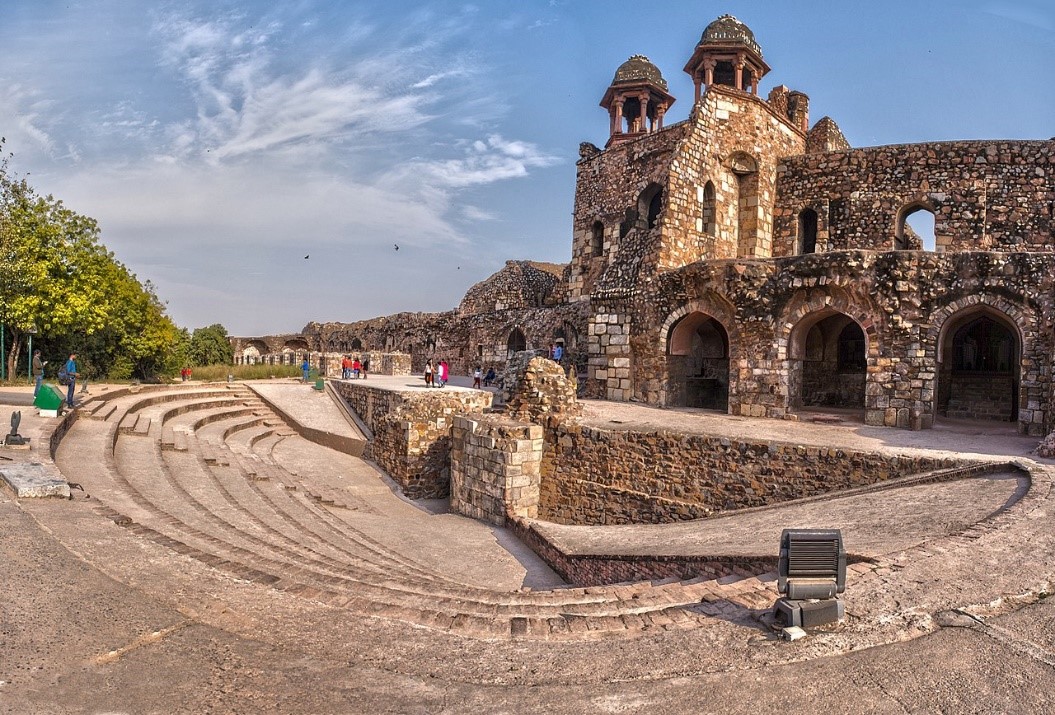
Old Fort(Purana Quila) as seen from Humayun Gate
The Suris (1540-55 CE)
Sher shah Suri (1540-45 CE)
Initially known as Farid was a small jagirdar of Sasaram, Bihar. He defeated Humayun in Chausa and Kannauj, establishing the Suri empire in North India.
- He re-established law and order in the empire.
- His empire extended from Bengal to the Indus, except Kashmir, and in the west, he conquered Malwa and almost the entire Rajasthan.
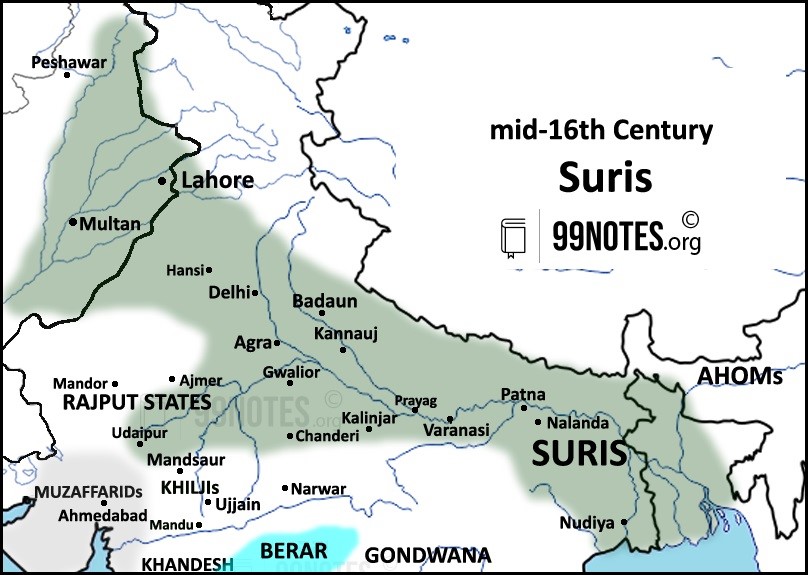
- Promoted Trade and commerce:
- He restored the old Grand Trunk Road, from the river Indus in the west to Bengal in the east.
- He built several Sarai (Inn) and placed every two kos (about eight km) on trunk roads. Separate arrangements were made for Hindus and Muslims in these sarais.
- He also tried to fix standards of weights and measures.
- He undertook currency reforms and struck coins of gold, silver and copper of uniform standards. His standardised Rupiya(Silver coin) was the main currency till the British time.
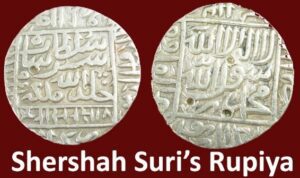
- Improved revenue and administrative system:
- Todarmal developed a Land revenue system known as Jabti/Bandobast under his reign.
- Sher Shah followed the pattern of administrative division as prevailed during the Delhi sultanate.
- He borrowed dagh (branding) and chehra (descriptive roll) from military reforms undertaken by Allauddin
- He built a new city on the bank of River Yamuna, of which only Purana Qila(initially built by Humayun) survives today. He also built his tomb at Sasaram (Bihar).
- Malik Muhammad Jayasi wrote the epic poem Padmavat during his reign.
- The decline of Suris:
- Sher Khan’s second son, Islam Shah, succeeded Sher Shah, who ruled until 1553. However, internal rebellion and constant fear of a renewed Mughal invasion prevented Islam Shah from attempting to expand his empire.
- His death at a young age led to a civil war among his successors, which allowed Humayun to recover his Empire in India.
- Sher Shah’s excessive centralisation of authority ultimately weakened the Suri Empire and became a cause of its end.
- Finally, in 1555, Humayun defeated the Afghans and recovered Delhi and Agra.

Sher Shah Suri Tomb at Sasaram
Consolidation of the Mughal Empire
Akbar (1556-1605 CE)
- Akbar was born in Amarkot in 1542, where Humayun had taken refuge and had to be taken away by his uncle, Kamran. The Mughal family could reunite only after the capture of Qandahar.
- After Humayun’s sudden accidental death, Akbar was crowned in 1556 at the age of thirteen.
- Phases of Expansion under Akbar:
- Initial Rebellions:
- Hemchandra Vikramaditya(Hemu) was the Wazir under Adil Shah Suri, who regrouped the Afghans against the Mughals. Akbar’s Wazir Bairam khan defeated Hemu in the second battle of Panipat in 1556, finally ending the Suri Challenge.
- Bairam Khan managed the empire as regent of Akbar for almost four years. In these four years, the empire’s territories were extended from Kabul and Ajmer in the west to Jaunpur in the east. Akbar dismissed Bairam Khan from his services in 1560, after which he rebelled and was defeated by eighteen-year-old Akbar.
- Conquest of Ganga plains under Akbar:
-
- Malwa was captured in 1561 from Baz Bahadur; later, he was made Mansabdar.
- Gujarat was won in 1572, which was ruled by Bahadur Shah.
- In 1574-75, Akbar was able to capture Bihar and Bengal, which were dominated by Afghans.
- Rathod Rajputs of Marwar:
- Chandrasen Rathod of Jodhpur, too, gave a hard time to the imperial Mughal forces. He entered into a matrimonial alliance with Rana Uday Singh of Mewar.
- Even after the fall of Jodhpur in 1564, he kept on fighting. Eventually, by the 1580s, Mughal forces brought all of Marwar under their control.
- Conflict with Sisodia Rajputs of Chittor:
- Chittor fell in 1568 after a fierce six-month-long battle. Rana Uday Singh then retired to Hills.
- Rana Uday Singh was still in control of Udaipur’s hilly areas. He was succeeded by his son Rana Pratap, who refused to accept Mughal Suzerainty.
- The fall of Chittor was followed by Ranthambore, which fell in 1569.
- The battle of Haldighati (1576) was fought in which Rana Pratap faced setbacks and escaped; however, he continued his resistance through guerrilla warfare, and Akbar could never win the rest of Mewar.
- Expansion beyond Ganga Plains:
- Captured Kashmir in 1586 in order to block all roads to Uzbekistan.
- The conquest of Sindh happened in 1590.
- Orissa was captured by Raja Man Singh, the Mughal governor of Bengal, in 1592.
- Expedition against Deccan Sultans: After settling affairs in the northwest, he sent an expedition to Deccan under Abdul Rahim khan-i-Khanam in 1593.
- He besieged Ahmednagar Fortin 1595, forcing Chand Bibi to cede Berar;
- He took Khandesh and established the Subas of Ahmadnagar, Berar and Khandesh under Prince Daniyal.
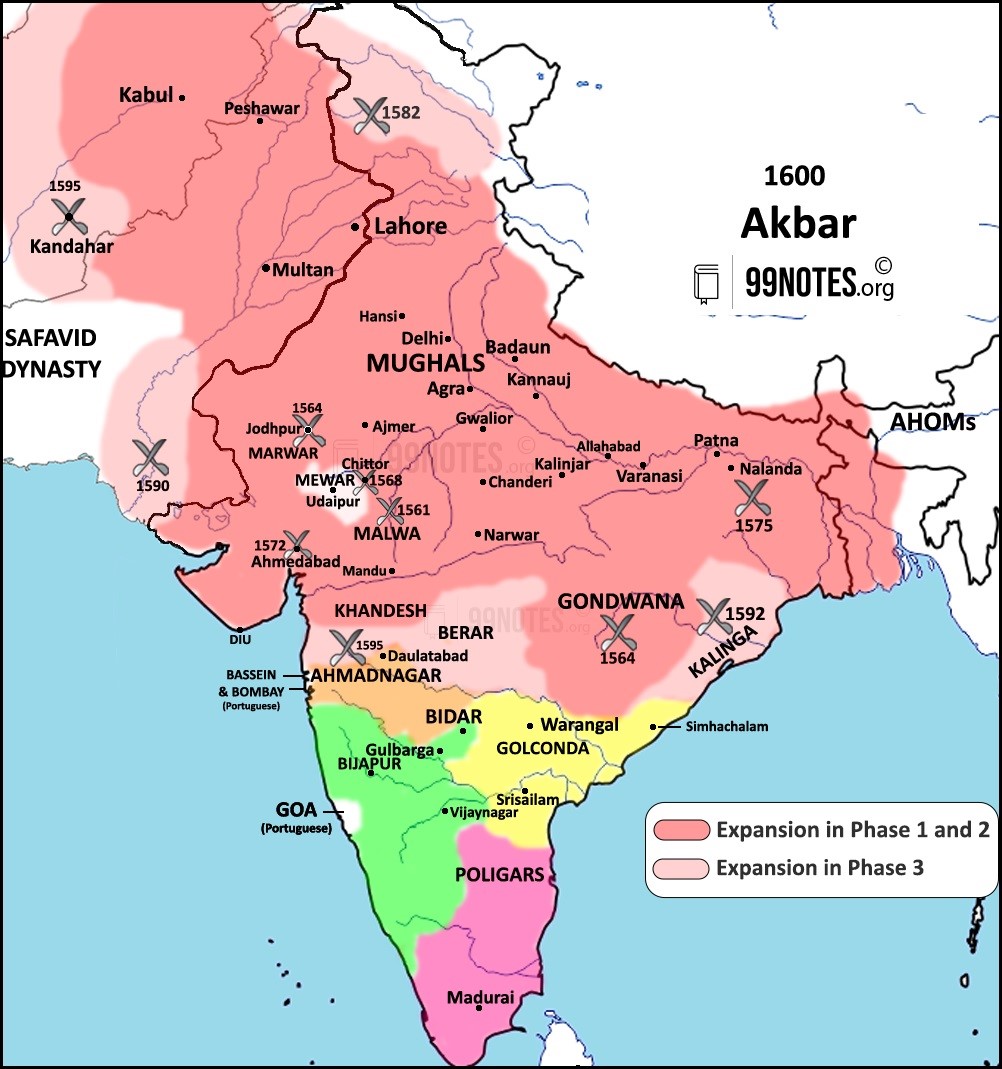
- Akbar’s Administration
- Akbar’s Revenue System:
- Jabti System for land revenue: was adopted from the Suris, in which revenue was paid according to the annual assessment of productivity.
- But later, he modified it and adopted the Dahsala system in which the average yield of the Past ten years was used for productivity assessment.
- However, in some areas, other systems like jabti, batai and nasaq/kankut were used to calculate revenue.
- Military Administration:
- Akbar organised his army and nobility under the Mansabdari system(link), where each officer was assigned a rank (mansab).
- He continued with the existing local administration, and Pargana and Sarkar
- The central Asian tradition of the all-powerful Wazir was done away with.
- Akbar’s Revenue System:
- Akbar’s Religious Policy:
- Religious Freedoms got revived:
- He abolished Jizyah and pilgrimage tax, a symbol of Muslim domination and superiority.
- He also stopped the practice of forcibly converting prisoners of war to Islam.
- Akbar gave complete religious freedom to his Hindu wives and gave a respectable place to their parents and relations in the nobility. His Rajput policy aligned with his policy of tolerance toward non-Muslims.
- Religious Freedoms got revived:
- Religious Reforms under Akbar:
- He stopped the practice of forced sati and legalised widow remarriage.
- He also tried to reform education and emphasised secular subjects like mathematics, astronomy, logic etc.
- ‘Suhl-i-kul’
- He built Ibadat khana, where he would discuss various religious and philosophical ideas.
- According to Badayuni, he also propounded a new religion called Din-i-Ilah, which included ideas from different religions.
- His religious policy is known as ‘suhl-i-kul’ (universal peace).
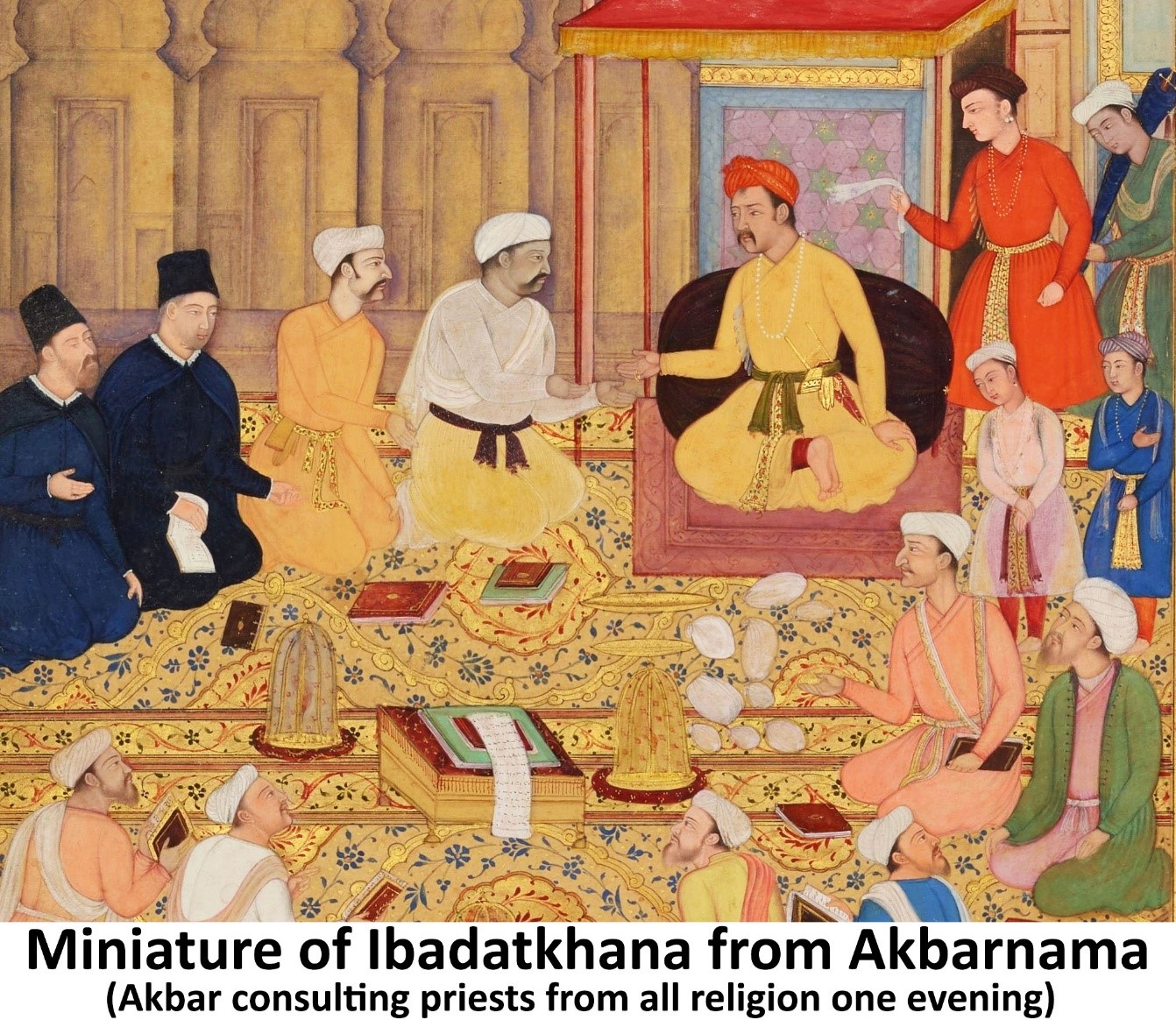
- Abul Fazal wrote his biography,
- Navaratnas or the nine gems: According to popular tradition, the court of the Mughal ruler Akbar had nine intellectuals called the Navaratnas, but there is no agreement over who these were. Some of these could include the following:
- Bairam Khan,
- Abdul Rahim Khan-i-Khanan (Bairam Khan’s son and court Poet Rahim)
- Raja Birbal,
- Abu’l-Fazl ibn Mubarak,
- Man Singh I,
- Mulla Do-Pyaza,
- Tansen,
- Faizi,
- Todar Mal,
- Hakim Humam,
- Abd al-Qadir Badayuni.
Jahangir (1605-1627 CE)
- Prince Salim Succeeded his father Akbar in 1605 with the title Nur-ud-din Muhammad Jahangir.
- Military Achievements:
- Shortly after his succession, his son Khusrau broke out in rebellion but was defeated near Lahore by Jahangir and imprisoned.
- He pursued expansionist foreign policy against Deccan but achieved little success due to strong resistance from Malik Ambar of Ahmad Nagar.
- During his reign, Mughal power was firmly established in eastern Bengal.
- Agreement with Mewar:
- Amar Singh, the king of Mewar, accepted the Mughal sovereignty due to Mewar’s poor economic conditions, ending the four-decade-long struggle.
- He was given a Mansabdari with a Zat of 5000 and 5000 Sowar.
- Mughals agreed that the king of Mewar need not submit himself to the Mughal court and neither be forced into a Matrimonial alliance.
- In exchange, Amar Singh was given the Chittor fort back, with the condition that he could not repair it, to guarantee that Mewar did not become strong enough to exercise its independence.
- British Influence on Jahangir:
- The first British envoy, led by William Hawkins, came to meet Jahangir in 1608. But, the Mughals were not interested in dealing with the Europeans.
- However, a British Conflict with the Portuguese changed the Mughal attitude towards the British. In the Battle of Swally of 1612, the East India Company, led by captain Thomas Best defeated the Portuguese in a naval battle near Surat.
- This impressed the Mughals since they were nervous about Portuguese settlements in Surat, Diu, Dadar and Nagar Haveli, Bassein and Bombay.
- In 1615, when Thomas Roe visited India, Jahangir allowed him to construct a factory in Surat and appointed him as a Mansabdar with a zat of 400.
- In 1611, Jahangir married Mehr-Un-Nisa. Mehr-Un-Nisa (Nurjahan) was the wife and chief consort of the Mughal Emperor Jahangir from 1620 until his death in 1627.
- Jahangir’s addiction to alcohol and opium made it easier for Nur Jahan to exert her influence over Jahangir wielding great power.
- She was given the title of Badshah Begam, and even coins were issued in her name.
- She had the privilege to grant farmans.
- Nur Jahan formed a powerful in-group of family members, which included herself, her father Mirza Gayas Beigh, her brother Asaf Khan and prince Khurram(Shah Jahan), to exercise her powers. Such a group is referred to as a Junta (a Latin word referring to a powerful political group).
- Nurjahan’s Influence on Mughal Art:
- Due to Nurjahan’s influence, Persian art and culture flourished in the court.
- In his architecture, pietra dura (art using semi-precious stones) started being used. E.g.: Tomb of Itimadulla.
- She contributed insignificantly by introducing a variety of new textiles such as nurmahali dress, silver-threaded brocade (badla) and silver-threaded lace (kinari).
- From 1622-26, His son Khurram (Shah Jahan), along with Malik Ambar of Ahmadnaagr in Deccan, rebelled against Jahangir. Mahabat Khan defeated him, and later Jahangir pardoned him.
- Contribution to Art and Culture:
- He continued with Akbar’s religious policy of Suhl-i-kul.
- Jahangir focused less on architecture but patronised paintings, particularly the portrait style. He introduced the use of the halo in portraits.
- He wrote his autobiography, Tuzuk-i-Jahangiri, in Persian.
Shah Jahan (1627-1658 CE)
- Prince Khurram, also known as Shah Jahan, defeated his youngest brother Shahryar Mirza and crowned himself Emperor in the Agra Fort after Jahangir’s death in 1627.
- Military Achievements of Shah Jahan:
- His attempt to capture Qandahar proved to be futile, but his Deccan policy was more successful as compared to Jahangir and Akbar.
- In 1632, he defeated the Portuguese near Hughli in Bengal due to their constant misuse of trade privileges.
- Several foreign travellers like Bernier and Tavernier of France and Mannuci of Italy have written accounts of Shah Jahan’s reign. Peter Mundy described famine in his reign.
- Art in Shah Jahan’s time:
- His reign is known as the golden period of Mughal architecture. In 1631, he started the construction of the Taj in memory of his beloved wife, Mumtaj Mahal.
- Mosque building and fort building reached their peak during his reign. The Famous Peacock throne was also built.

Peacock throne
Source: https://en.wikipedia.org/wiki/Peacock_Throne#/media/File:Sixteen_views_of_monuments_in_Delhi_Peacock_Throne_Red_Fort_Delhi_1850.png
- The later period of his rule was marked by a war of succession among his four sons in which Aurangzeb defeated Darashikoh in the battle of Samugarh in 1658 and later in the Battle of Deorai in 1659.
- Shah Jahan was put under confinement by Aurangzeb in Agra fort, where he died in 1666.
Aurangazeb(1657-1707)
- He ruled for almost fifty years, during which the territories of the Mughal Empire reached their zenith.
- At its peak, it stretched from Kashmir in the north to Jinji (In Tamil Nadu) in the south and from the Hindukush in the west to Chittagong in the east.
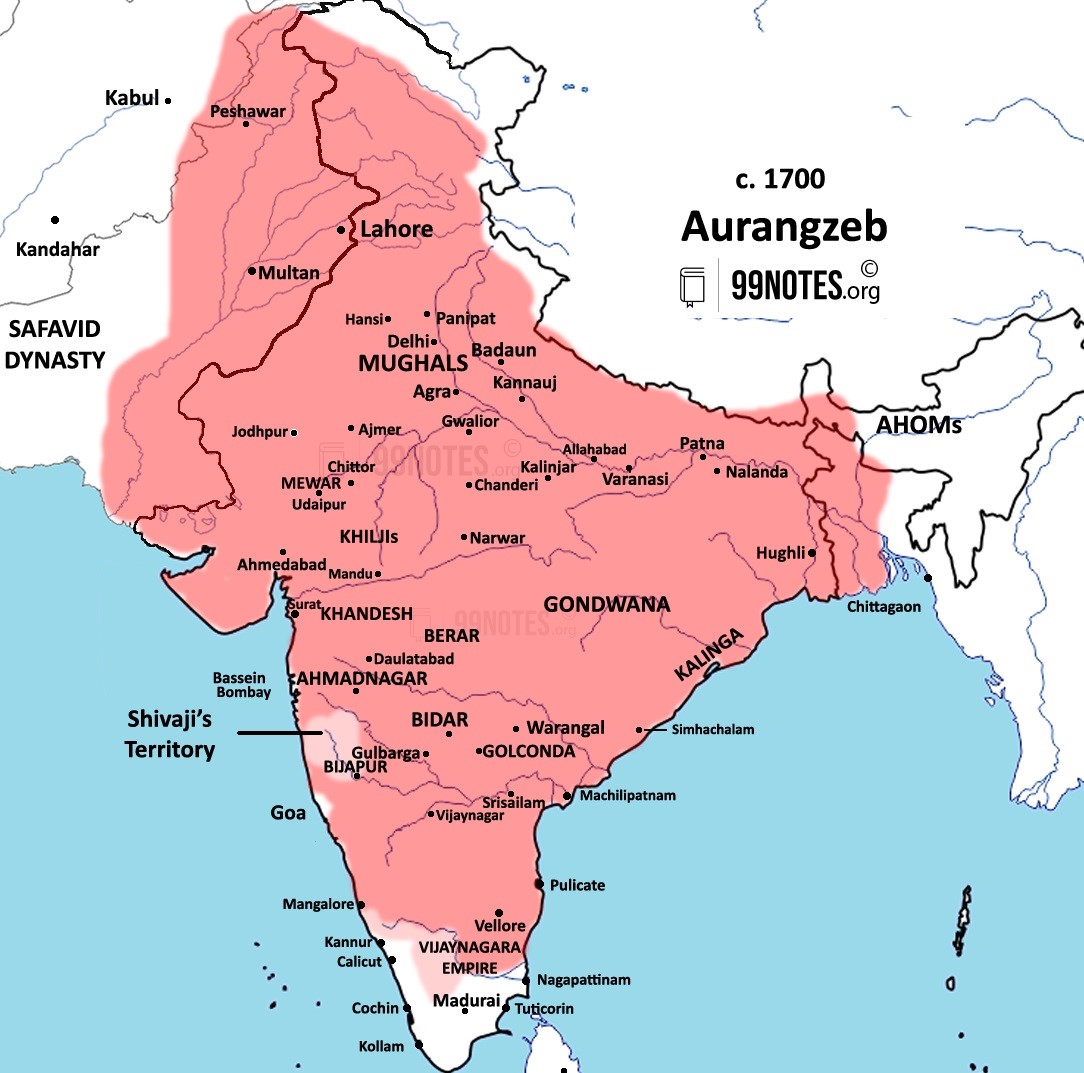
- His destruction of Deccan is considered a political blunder and termed by Historians as the Deccan ulcer as it led to direct confrontation with Marathas, and it also severely affected Mughal coffers.
- Marathas under Shivaji and later his successors defied the Mughal Empire under Aurangzeb, and after his death, they emerged as a significant political power.
- He sent expeditions against Ahoms (battle of Saraighat 1671) but met with limited success.
- He adopted a harsh religious policy which angered non-muslims and possibly led to several rebellions, such as the Jat rebellion in 1669 and 1685 and the Satnami rebellion in 1672.
- He also ordered the execution of the ninth Sikh Guru Tegh Bahadur, which led to the Sikh rebellion in 1675.
- He banned the festival of Nauroj along with Moharram since Shias practised them. His campaign against Deccan was also linked with his hate for Shias.
- He forbade music in the court, re-imposed Jizyah, levied custom duty only on Hindus and appointed officials to enforce moral codes and sharia.
- Due to his lifestyle of strict adherence to Islamic values, he was referred to as Zinda Pir (living saint).
- After his death, the empire lost its previous status, and his successor turned out to be weak and could not keep the empire consolidated.
Relation of Mughals with Rajputs
- Akbar’s Relations with Rajputs: The steadfast loyalty provided by the Rajputs was the most significant factor in the consolidation and expansion of Akbar’s Empire.
-
- Those Rajputs who submitted before Akbar was treated with honour and were appointed as Mansabdars.
- He made a matrimonial alliance with the Rajputs and married Raja Bharmal’s daughter Haraka Bai.
- Jahangir was able to bring Amar Singh, the king of Mewar, under Mughal sovereignty after a four-decade-long struggle, finally controlling all of Rajputana. Although Mewar and Marwar were given considerable independence and therefore were known as Watan Jagirs.
- Aurangzeb Aurangzeb alienated the Rajputs by intervening in their internal politics of succession. He also adopted a harsh religious policy which was not appreciated by the Rajputs.
Mughal Administration
Administrative Units
- Many administrative features of the Mughal Empire were retained by the Delhi sultanate and Sher Shah Suri.
- Akbar divided his empire into fifteen Subas, which increased to twenty during Aurangzeb’s rule.
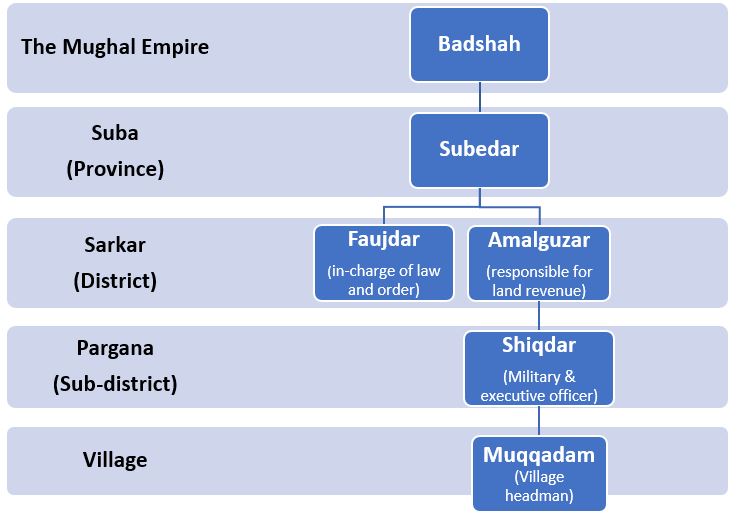
Revenue administration
- The Dahasala system was introduced by Akbar in which an average yield of 10 years was calculated for taxation. It was an improvement of the earlier prevailing Jabti system.
- Besides Dahsala, Batai or Galla Baksh, Kankut and Nasaq systems existed as well, which were used in certain conditions.
-
- Batai/Galla Baksh – After the harvest, the crop was divided into equal heaps, of which specified heaps were taken by the officials.
- Kankut – The estimate of produce was determined on the basis of a sample survey.
- Nasaq – Revenue payable was estimated on the basis of past experience.
- Zamindars: They were petty landholders who retained their ancestral lands. They had hereditary rights to collect land revenue which could go up to 25% of the revenue. However, in Mughal Era, the Zamindar was not the owner of the land, and he could not dispossess the peasant of land as long as they paid land revenue.
- Officials of the land revenue administration
| Karori | In charge of both assessment and collection of the revenue. |
| Quanungo | He was the local revenue official of the pargana. |
| Chaudhary | A countercheck on Quanungo also stood for surety of repayment of taccavi loans. |
| Patwari | He maintained records of the village land, the holdings of the individual cultivators, the variety of crops grown and details about fallow land. |
- Classification of land based on the fertility of the soil
| Polaj | Cultivated every year. |
| Parati | Remain fallow once in two years. |
| chachar | Remain fallow for three or four years |
| Banjar | Remain fallow for more than five or more years. |
- Classification of land for revenue collection
| Jagir | Allotted to Jagirdar, usually nobles and the royal family. |
| Khalisa | The tax went to the royal exchequer. |
| Inam | To learned and religious men. |
- Types of Jagir
| Jagir Tankha | Given in lieu of salary |
| Mashrut Jagir | Given on certain conditions. |
| Inam Jagir | Given with no obligation; independent of mansab |
| Watan Jagir | Assigned to Zamindars in their homelands |
The Mansabdari system and Military Organisation
- Introduced by Akbar to organise both the nobility and the army. However, its origin can be traced to the decimal system adopted by Genghis Khan.
- Under this, each officer was assigned a ‘mansab’ or rank. The lowest rank was 10, and the highest was 5000 for the nobles.
- All mansabdars were paid in cash or in the form of a jagir.
- All jagirdars were mansabdars but not all mansabdars were jagirdars.
- Initially, there was only one rank, ‘mansab’, later divided into Zat and Sawar. Zat means a person’s status and salary, while Sawar implies the number of cavalrymen (sawars) a person was required to maintain.
- Dagh (branding of horses) and Chehra (descriptive roll) system were introduced in the army.
- Mir Bakshi was the head of the military department and assumed many responsibilities under him:
-
- Considered the head of the nobility.
- He recommended for appointment of mansabs and their promotion.
- He was also the head of intelligence. Intelligence officers (Barid) and news reporters (Waqia Navis) reported to him.
Central administration and officials
- Wazir held the highest position in the hierarchy of the administration. However, Akbar took away his financial powers and entrusted them to the hands of Diwan-i- Kul/ Diwan-i-ala (Finance minister).
- The head of the military department was Mir Bakshi. He, and not the Diwan, was considered the head of nobility.
- The governor of the ports was called mutasaddi, who the Emperor directly appointed.
| Wazir (diwan-i-Ala) | Managed revenue affairs |
| Mir Bakshi | Head of military and intelligence department |
| Mir Saman | In charge of the imperial household and royal karkhanas |
| Qazi-ul-Quzzat (chief Qazi) | Head of the judicial department |
| Sadr-us- Sudur | Head of the religious department; responsible for the protection of the laws of Shariat |
| Muhtasibs | Ensured the general observance of the rules of morality |
| Mutasaddi | Governor of ports; directly appointed by the Emperor. |
Provincial administration of Mughal Empire
There was a uniform provincial administration with fixed territorial units. However, certain minor amendments were made to suit the local circumstances.
| Suba/province | • Subedar/Sipahsalar/Nayim – Governor of the Suba.
• Diwan– In charge of revenue administration. • Bakshi – military commander at the military level. • Kotwal – chief of the city police. • Sadr and Qazi – Judicial officers of the Suba. |
| Sarkar/District | • Fauzdar – Executive and military officer.
• Amal-Guzar – finance officer • Khazandar – Treasurer. |
| Pargana | • Shiqdar – Military and executive officer.
• Amil – Finance officer. • Fotadar – Treasurer. • Quanungo – Head of village patawaris. |
| Gram/Village | • Muqqadam – Headman
• Patwari – Accountant • Chowkidar – Watchman |
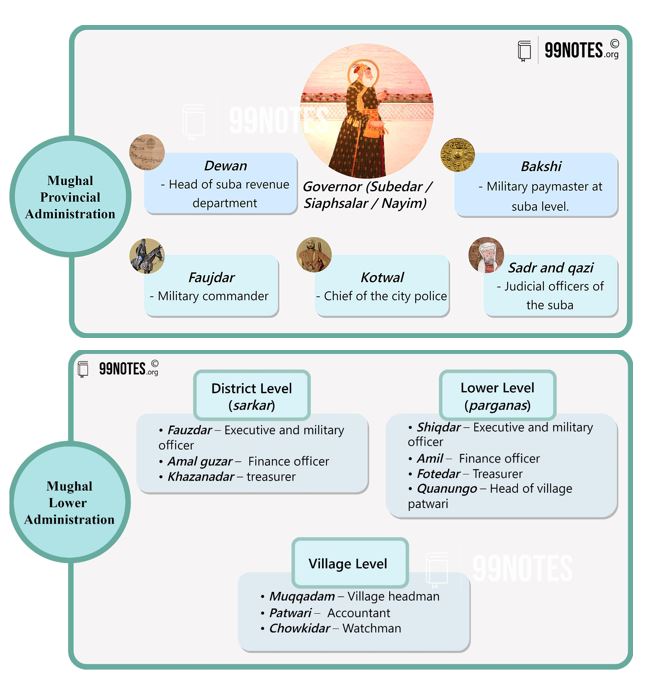
In the following articles, we shall see the socio-economic impact of the Mughal empire and its decline.

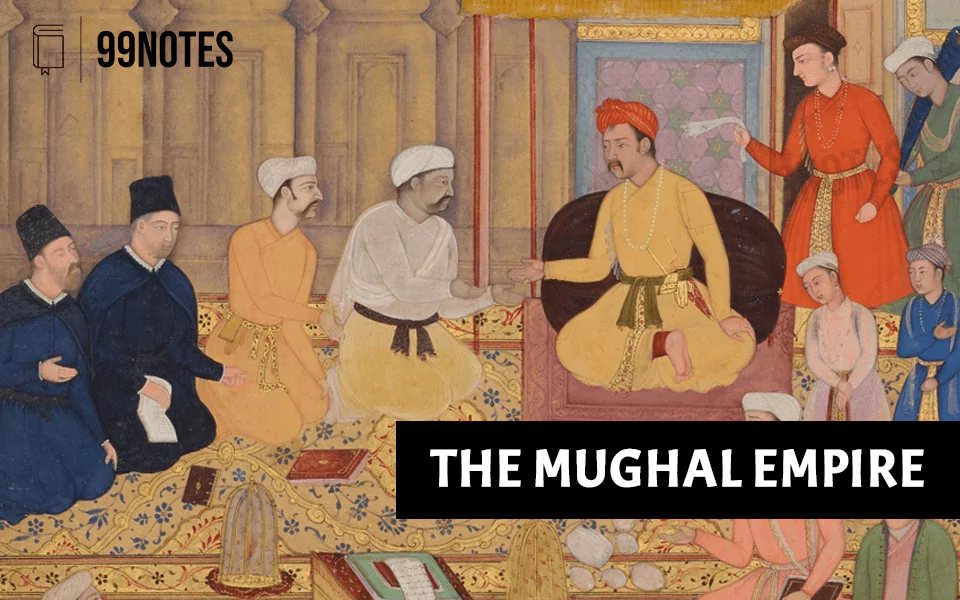

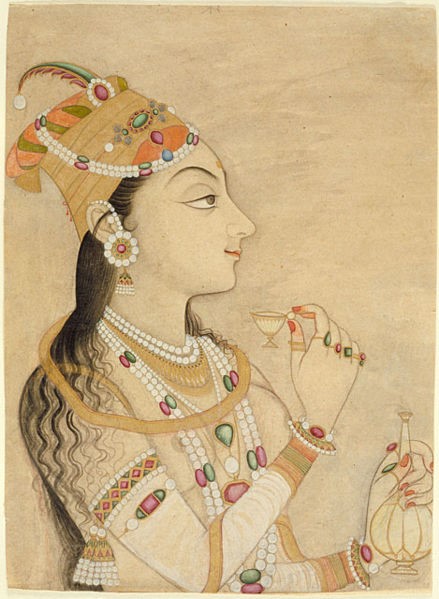
![Tripartite Struggle (790-1162Ad) History, Cause &Amp; Consequences [Upsc Notes] | Updated July 27, 2024 Tripartite Struggle (790-1162Ad) History, Cause & Consequences [Upsc Notes]](https://99notes.in/wp-content/uploads/2022/12/tripartite-struggle-featured-768x500.webp)
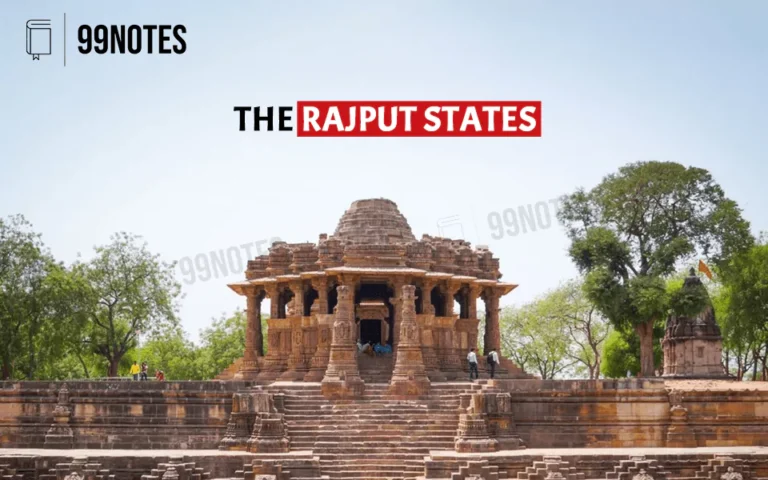
![Bhakti Movement: Origin, Main Principles, Causes, And Its Effect [Upsc Medieval History Notes] | Updated July 27, 2024 Bhakti Movement: Origin, Main Principles, Causes, And Its Effect [Upsc Medieval History Notes]](https://99notes.in/wp-content/uploads/2023/02/the-bhakti-momvement-banner-99notes-upsc-768x480.webp)
